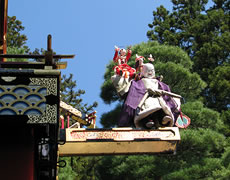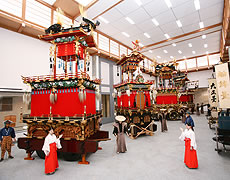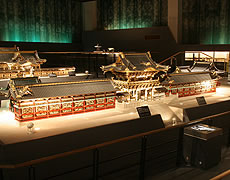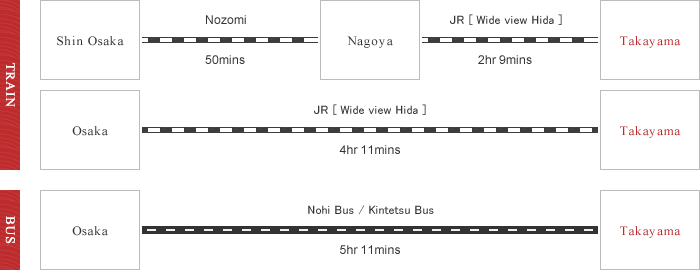HISTORY

The origins of Sakurayama Hachimangu Shrine date from the time of the Emperor Nintoku (413 - 439), when he reguested Prince Takefurukuma-no-mikoto to subjugate the monster Ryoumen Sukuna, an incredible beast with 2 heads, 4 arms and 4 legs.
Before undertaking his task, the warrior enshrined his father, the Emperor Ojin as the deitty of this sanctuary, and prayed for the success of his missiuon.
In 1683, through the benefaction of Lord Kanamori, the shirine was enlarged and offcially established for the protection of the town.
More than 1,500,000 people vist the shirine annually.
FESTIVAL
The focus of the festival is the magnificent floats which are pulled through the strees of the town.
The Takayama Matsuri actually composed of two festivals: the Spring Festival (April 14th and 15th), in which 12 floats take part, and the Autumn Festival (October 9th and 10th) which features 11 floats.

The Takayama Festival began about 350 years ago as a simple village ceremony. Since Takayama is in Hida, the center of Japan’s timber producing region, the town grew as an important distribution center for the area, attracting large numbers of sake brewrers, cloth merchants, woodworkers, and other craftsmen. As the result of these rich merchants’ support, and the pride in the high quality work of the artisans, the floats beccame more and more magnificent, as a result of competition developed among the various districts of the town.
PUPPETS

Hotei tai has puppets performance.
These wooden dolls wearing silk and brocade are manipulated with strings and push rods from within the float by expert puppeteers.
The three marionettes, on the Hoteitai (The God of Fortune) have 36 strings which require the skills of 9 puppet masters.
The doll becomes almost lifelike as it performs a series of complex gestures, turns, and other movements.
YATAI KAIKAN
The Floats are nomally stored in "Yatai gura", special thickwalled storehouses with very tall doors, which can be seen in various districts of the town. However, the Sakurayama Hachiman Shrine has received special permission to display four of the eleven Autumn festival in the exhibition hall so that visitors can see them as they appear on the day of the festival. The floats on display are changed three times a year.

Try to imagine the festival procession at twilight. Glowing lanterns highlight the gold and lacquer of the Floats as they are pulled across one of the bright red bridges that cross Takayama’s many small rivers, the colors reflecting on the water. As the procession moves along to the sounds of the festival music, it still remains a spectacle of the festival in Edo period.
We hope you will enjoy your vist to Takayama and extends a special invitation to return to our city to see the Festival !
TAKAYAMA MATSURI YATAI KAIKAN
[ The Takayama Festival Floats Exhibition Hall ]
[ Telephone ] 0577-32-5100 / [ Facsimile ] 0577-32-5166 / [ URL ] http://www.hidahachimangu.jp/
Located on the grounds of Sakurayama Hachiman Shrine 1.3km from Takayama Station ; 20 minutes on foot. Open all year around
9:00 A.M. to 5:00 P.M. (Mar. to Nov.) 9:00 A.M. to 4:30 P.M. (Dec. to Feb.)
NIKKOUKAN

One-tenth scale replica of Nikko-Toshogu Shrine are exhibited in this museum.
Nikko-Toshogu enshrined Ieyasu Tokugawa (the first Shougun (generalissimo) Tokugawa shogunnate), which is located in Tochigi-pref, near Tokyo.
It took 15 years to make this, master work around the Taisho era (1912-1925), and 33 skillful carpenters were engaged in. It contains of 28 buildings, Main shirine, Worship Hall, Five storied pagoda and so on. This replica had been shown in various parts of the United States after the war, and when Aoi haku (the exposition in Okazaki) was held in 1990, this replica had been shown in Japan 30 years later.
And after that, by owner’s will, this replica is stored in this shirine eternally.
In the Nikkokan, a computerized lighting system is used to reproduce from the sunrise to sunset at Nikko.
ACCESS
From Tokyo

From Osaka

From Nagoya

COPYRIGHT © SAKURAYAMA HACHIMANGU SHRINE. ALL RIGHT RESERVED.

